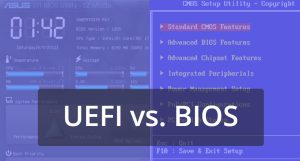
Upon pressing the power button of the computer, we witness the booting of the operating system, be it Windows, MacOS, or Linux – familiar platforms that we engage with daily. The operating system acts as an intermediary between the computer hardware and the user, thereby simplifying the interaction process. But what occurs prior to the operating system’s initiation? Is there any activity at all? How does the computer discern that it should boot the operating system, displaying your exact desktop with its unique icons and folders? Without the initial load of a special program known as the BIOS, the computer would merely gather dust on the desk, inert after being powered on. In this article we will look at the purpose and functions of the BIOS and compare them with newer similar UEFI software.
About BIOS
The BIOS (Basic Input/Output System) is a set of micro-programs that manage hardware operations of a desktop or laptop computer. It boots up when the computer is turned on and is responsible for activating its hardware components, ensuring they operate correctly. If all is well, the operating system’s boot loader is initiated. The process of BIOS checking and loading is very brief, often lasting less than a second, yet this program is of immense significance. It could be considered the most crucial micro-program on a computer. Physically, the BIOS resides on the motherboard and consists of a special chip with the loaded software. With BIOS clarified, let us explore what UEFI is.
What is UEFI?
UEFI (Unified Extensible Firmware Interface) essentially serves the same purpose as BIOS. Yes, it also boots up the operating system, but it does so in a fundamentally different way. UEFI itself has characteristics of an operating system, such as a graphical interface, loading certain drivers upon initialization, and a comprehensive set of tools for activities like monitoring all parameters, flexible system boot settings, archiving and restoring, and network updates. UEFI supports larger hard drives, boots faster, and is more secure, as it has a crucial component called Secure Boot, which protects the system from malicious boot processes. Almost all new computers use UEFI firmware in place of the traditional BIOS. But both these programs are examples of low-level software that runs when the computer starts, before the operating system boots.
Key Differences
Let’s look at the main differences in these softwares and understand how they differ.
BIOS
- An older technology present in computers since their inception.
- Employs a booting system based on the Master Boot Record (MBR) limited to a disk size of up to 2 TB and up to four partitions.
- Typically features a text-based interface without mouse support.
- Offers fewer security features compared to UEFI.
- Boots the operating system’s loader more slowly than UEFI.
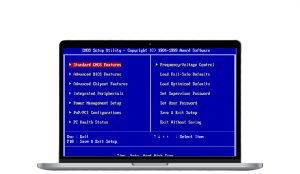
UEFI
- A modern replacement for BIOS, offering greater capabilities and improvements.
- Supports booting from the GUID Partition Table (GPT), allowing the use of larger disks (over 2 TB) and the creation of more partitions.
- UEFI interface is graphical, supports mouse use, and is user-friendly.
- Includes security features like Secure Boot, which protect the boot process from malicious software.
- Offers network capabilities such as booting from a network server (Network Boot).
- Boots operating systems faster thanks to an optimized boot process.Therefore, UEFI provides higher flexibility, better hardware support, and enhanced security compared to traditional BIOS.
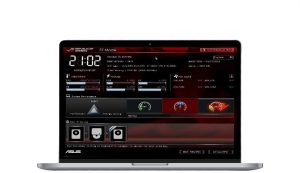
How to find out what is used on my PC?
On most modern PCs, you’ll encounter UEFI; however, if there are any doubts, this can be very simply checked.
Invoke the Run dialog (Win+R) and enter the command «msinfo32».
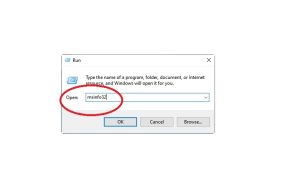
When the System Information window appears, check the “BIOS Mode” entry.
If it says “Legacy,” this indicates the use of the outdated boot technology.

On the other hand, if you see “UEFI,” your system is already running the newer firmware interface.
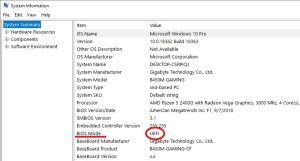
Is it possible to update from BIOS to UEFI?
You cannot directly “update” from BIOS to UEFI as they are fundamentally different types of firmware. In some cases, it might be possible to switch from BIOS to UEFI. It’s important to understand that installing UEFI in place of BIOS is only possible if the appropriate firmware for your motherboard/notebook is available on the manufacturer’s website. If we’re talking about an inherently old PC, you won’t be able to switch from BIOS to UEFI simply because outdated hardware wouldn’t support the new standard. At the same time, UEFI is compatible with not the latest hardware too and provides Legacy emulation for old systems that need it.
How can I install UEFI instead of BIOS if my motherboard supports UEFI?
If your motherboard is already equipped with UEFI, but the default is BIOS compatibility mode (Legacy mode), then you can enable UEFI as follows:
- Enter the Firmware Interface
Restart your computer and, during the boot process, press the key that opens the firmware settings (commonly Delete, F2, F10, F12, or Esc).
- Locate the Boot Mode Settings
In the firmware settings menu, find the section related to the system’s boot options (usually under tabs like Boot, Security, or Advanced).
- Change Settings from Legacy to UEFI
Look for the Boot Mode option within the boot settings, where you can select UEFI instead of Legacy or BIOS.
- Disable CSM (Compatibility Support Module)
If a CSM option is available in the firmware, disable it to ensure the system fully transitions to UEFI without the old Legacy mode support.
- Save Changes
Save the settings and restart your computer (typically using the Save & Exit option or F10).
- Reinstall the Operating System (if necessary)
After enabling UEFI mode in the firmware, you may need to reinstall the operating system using media that supports UEFI (such as a USB flash drive formatted with GPT). This is because operating systems are installed differently under UEFI to work with the GPT partition table, rather than MBR.
In what cases do you choose BIOS instead of UEFI?
One of the main reasons for opting for Basic Input/Output System instead of UEFI is that BIOS has better compatibility with a wider range of hardware and software. It has been around longer, so it has been more thoroughly tested and debugged.
Furthermore, BIOS is less resource-intensive compared to Unified Extensible Firmware Interface, making it a better choice for older or less powerful computers.
Despite the advantages of UEFI, many prominent programmers, including Linus Torvalds, the creator and lead developer of Linux, argue that UEFI introduces unnecessary complexity with its superfluous drivers, flexible and modular construction – aspects that, regardless, will not be utilized by operating systems.
Conclusion
Technologies are evolving rapidly, and the switch from BIOS to UEFI is an inevitable step. For a vast majority of PC users who are neither professionals nor enthusiasts, the shift from BIOS to UEFI went unnoticed, having no impact on their daily tasks. For specialists, working with UEFI has become more functional due to its extensive customization options, though the transition to the new system and the initial learning curve presented some challenges.
